
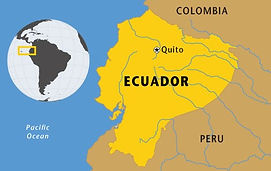
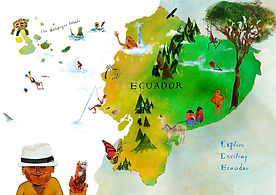
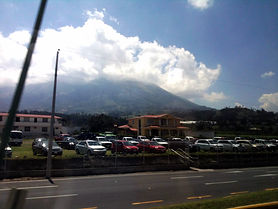



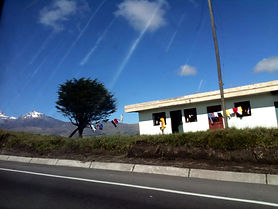
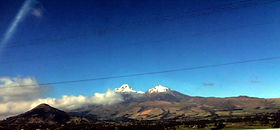

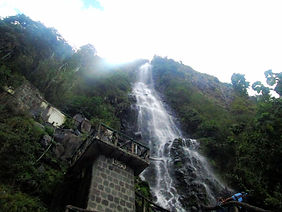
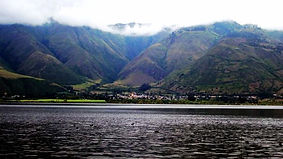
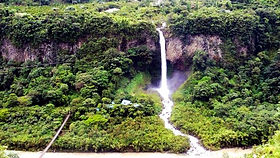
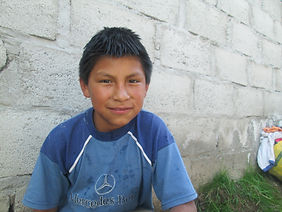
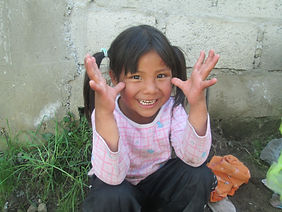
Ecuador: What you need to know
Ecuador is a small country in South America next to Colombia and Peru. The CIA World Factbook says it’s about the size of Nevada, which means nothing to us, but if you know how big Nevada is, there you go! Ecuador is located right on the equator (hence the name!), and is home to many diverse animals and plants that can only be found here. The population is around 14.5 million people. It is home to the Andes mountains and the Chimborazo volcano, which is the highest point on earth (step aside Mt. Everest!). The official languages of Ecuador are Spanish and Kichwa.
It has three climate zones which are Costa, Sierra and Oriente. When most people think of Ecuador they think of the Oriente, which is hot and tropical. This area includes the Amazonian jungles on the east side of Ecuador. There aren´t many big cities in this part of Ecuador, but it is popular with more adventurous tourists. The more nature-loving types go to a city called Baños, which is in the Sierra, because there is a bike trail through the mountains which leads into the Oriente, but the majority of tourists still go to Quito which is in the Sierra, and is the capital of Ecuador. Guayaquil, Ecuador´s largest city, is in the Costa, which has more tropical climates. The Galapagos Islands are also a part of Ecuador and are a very popular (and pricey) tourist destination.
The Sierra is dry and cold, because of the altitude. Quito, in particular, is very high altitude and is usually cool and dry. However, it does have sunny days and heat waves, usually followed by afternoon downpours of rain.
The Costa is very hot and, as you might imagine from the name, on the coast. It has a tropical, humid climate and has many popular beaches.
Ecuador also has a lot of volcanoes. It is part of what is known as the ¨ring of fire¨, and has over 40 active volcanoes. Quito itself is surrounded by active and dormant volcanoes, and there are many volcanoes scattered throughout the Andes mountains. When it looks like a volcano is going to erupt, roads are closed and whole cities are sometimes evacuated. Ecuador is also prone to flooding, or, on the other hand, droughts. Because most of the electricity in Ecuador comes from water, when there are droughts, electricity is rationed and neighborhoods spend several hours a day with no power.
Revolution Ministries is based in Quito, the capital of Ecuador. Quito is the second-largest city in Ecuador after Guayaquil. Quito has about 2 million inhabitants and the city itself is enormous. Its divisions are often based on altitude, having a ¨low¨, ¨middle¨ or ¨high¨designation after the name of the neighborhood. This is because Quito is built in a valley, working its way up the mountains. As a rule, the higher up you go, the worse the neighborhood is, in poverty and danger. (Our ministry is stationed very high up in South Quito.) Robbery and theft are common in Quito, as a result of extreme poverty. To travel from end to end in Quito takes more than three hours!! It’s huge!
Here in Quito things are somewhat modern. There are malls, movie theaters, restaurants, etc. Still, it is much different than the US. The buildings are all made of concrete, most people buy their groceries from the small stores around the corner rather than in supermarkets, very few people have cars, and crossing from one neighborhood to the next can mean crossing from normal, middle class life into extreme poverty. Ecuador uses the US dollar, but the prices here are much lower. This is because jobs are almost impossible to find, and the majority of people are unemployed. If someone does get a job, it is almost always full-time, and full-time here can mean working from about 8am-8pm Monday-Friday, plus many Saturdays, and even longer if the boss says so. Employees get paid by the month, not the hour, so there is often no overtime pay (even though legally they are entitled to it). If an employee can't go to work one day because he/she is sick, that person will most likely lose his/her job, or face heavy fines, because the mentality is that if you don't want to come to work, a lot of other people would be thankful for your job! The normal Ecuadorian wage starts at about $360 a month, but some companies pay less than the agreed-upon amount.
All in all, life in Ecuador is hard. A person who is considered middle-class here would still be considered very poor in the US, despite the current economic difficulty in the States. The poverty leads to higher crime, higher alcoholism, higher domestic abuse, and many other negative consequences.
A lack of food, shelter and clothing in many Ecuadorian households is unfortunately to be expected in the economy of a developing nation. The nation struggles under the weight of tremendous international debt, and there is a sharp divide between the wealthier population and the extremely poor. There is very little that is done on behalf of the poor by the Ecuadorian government. According to the World Bank´s 2012 report, an estimated 27% of the population is living below the poverty line, which is defined in Ecuador as living on less than $2.33 per day. (It´s important to note that someone living on $2.34 would not be considered to live under the poverty line. These statistics are helpful for developing an understanding of a country, but they can also be wildly deceptive. For example, the poorest 20% of the population share only 4% of the population´s income.)
Complicating these issues is the fact that an estimated 30% of Ecuadorian households are run by a woman (2013), with at least 340,000 single mothers, according to the Ecuadorian Institute of Statistics and Censuses. These women are commonly the mothers of multiple children, and work long hours at low-income jobs to try to provide. Often their children, sometimes as young as four and five years old, are forced to work as well. According to the 2011 Findings on the Worst Forms of Child Labor, at least 10% of children ages 5-14 are forced to work to survive. The jobs done by children are usually dangerous and unhygienic. These situations also make these children especially vulnerable to trafficking and exploitation.
The Ecuadorian government provides free health care to its citizens, but it is extremely low quality. Government hospitals group many sick people together, with little regard for the health of surrounding patients. Despite health care being marketed as ¨free¨, patients are sent to buy supplies and medications at pharmacies, which can end up being very expensive. The hospitals themselves provide few services that are truly free. Those services which are free generally have long waiting times. Patients have to get to the hospital early in the morning in the hopes of being treated in the afternoon, for even the most basic check-up. They may wait all day in vain. Once they finally get seen, they are often sent away to wait somewhere else for another basic need, like a blood or urine test. Then they will have to take their results back to the first place and wait again. Terminally ill patients often have to choose between their jobs, which are their only means of survival, and their medical treatment, which is their only means of getting well. Often, treatments for these patients depend on machines which often break down, and the patients are sent away and told to come back in a month or two when the machines are repaired. Private clinics are available, but most are only slightly better care than the government-run facilities, and are very expensive. Health insurance is a luxury for the nation´s wealthy, and is not universally accepted.
Statistics about the nation´s educational system are extremely deceptive. The enrollment rates in primary school are recorded as being very high, but while most children are enrolled in school (as a legal requirement), many do not make it very far into the year before being forced to drop out, often to go work in the streets. This is because, while schooling, like medical care, is supposedly provided freely to Ecuadorian citizens, there are many hidden costs. All children are required to buy uniforms, shoes, books, and extensive lists of school supplies. They are also charged fees by the schools, despite this being illegal. These costs are unbearable to families living in poverty, and soon the children drop out and begin to work to support their families, or stay at home alone all day, missing out on the education they need to help bring them out of poverty.
Families living in these conditions are often driven to alcoholism, drug problems, depression, abuse and hopelessness. Hope for these families, and relief from these pressures, can only be found in the saving knowledge of the gospel of Jesus Christ.
Revolution Ministries hopes to witness a miraculous change in these conditions as more and more people are shown the love of Christ!